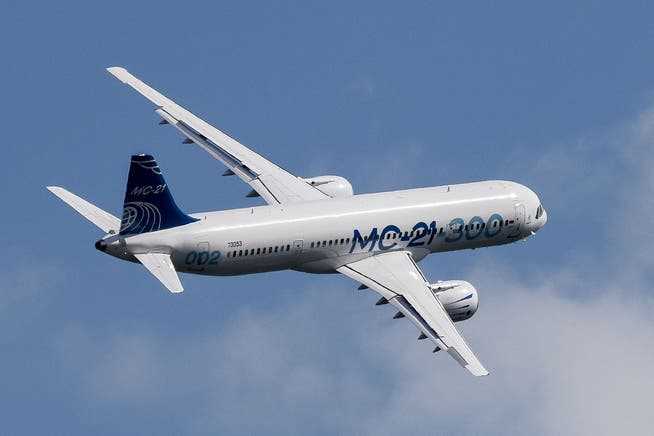With the approval of the Russian Irkut MC-21, a competitor is penetrating the core market of the western duopoly for the first time.
Window to the world market? The Irkut MC-21-300 could make the breakthrough and break through the Boeing-Airbus duopoly.
The end of 2021 was an exciting time for the Russian civil aviation industry, which had not made a name for itself in a long time. It has always remained a shadow of its earlier significance in Soviet times since the end of communism. Although almost all of the old locations in the gigantic country still exist, just 14 civil aircraft were built in Russia as a whole in 2020. In good times, Airbus achieves this in its various plants within a few days.
Some traditional Russian design offices such as Tupolev or Ilyushin have not produced a single civilian design for 30 years. But now, for the first time, Russia can present a new commercial aircraft which, according to experts, could even be superior in some areas to the current Airbus and Boeing models. Incidentally, this is no wonder, because the two top dogs in the extremely lucrative market have been resting on their laurels for many decades: the Boeing 737 in its original form dates from 1967, the Airbus A320 from 1987.
Now the Russians opposed it with the Irkut MC-21. First, the MC-21-300 as a basic model received its type approval by the Russian aviation authority on December 28, 2021, the type approval by the European Easa has been applied for. It was a long, thorny process, the first flight took place on May 28, 2017, after which four prototypes completed the test flight program.
Better profitability?
The standard version of the MC-21, designed for 163 seats in two classes, is aimed at the current western competitors Airbus A320neo and Boeing 737 Max 9, both in terms of capacity and range, according to current industry assessments, the MC-21 can certainly keep up. Whether this also applies to efficiency, reliability and performance remains to be seen in flight operations, which are due to begin this summer at Aeroflot subsidiary Rossiya. Experts believe it is quite possible that the MC-21 is more economical than its western competitors.
Passenger comfort, traditionally not a strength of Soviet and later Russian commercial aircraft, should not be neglected. Passengers can already expect a more generous feeling of space in the cabin: The MC-21 is not being advertised as “the widest narrow-body aircraft in the world” for nothing – it is 11 centimeters wider inside than the A320 and even 27 centimeters wider inside than the Boeing 737. This is not enough for the airlines to fit more than six seats per row, but it does give passengers more elbow room and a wider aisle, as a visit to the MC-21 recently at the Dubai Air Show proved. The manufacturer also proudly shows that the windows of the MC-21 are significantly larger than those of the western competition.
New materials
However, the signs on the side of Russian airliners are not looking good, because they have so far not been able to do without a variety of components from Western suppliers, especially for engines and composite materials. The MC-21 consists of 40 percent composite material – a record in this aircraft class – but which has so far been obtained from the USA and Japan. Just like the now-approved MC-21-300 is powered by the modern American Pratt & Whitney PW1400G geared turbofans. However, Russia cannot currently rely on these suppliers remaining available in the tense political situation.
At the same time, one sees important sales markets in Moscow in countries like Iran, to which one should not deliver any aircraft with western components anyway. So the Russians were forced to go back to their own abilities, for the first time following on from the often pioneering developments of their Soviet predecessors.
The aircraft presented in Dubai with the type designation MC-21-310 has not yet been approved because it is powered by the new Russian turbofan engine Awiadwigatel PD-14. The approval of this version is currently being worked on, and the long-distance flight of the prototype from Moscow to Dubai was an important milestone.
But the drive for technological autonomy from the West goes even further in the Russian aviation industry: On December 25, 2021, a prototype of the MC-21-300 with new wings made of Russian polymer composites flew for the first time. The locally produced material brings several advances: The aircraft is lighter, and the wings can be manufactured in an aerodynamically optimized form. “That cannot be achieved with metal wings,” explained Sergei Chemezow, the managing director of the Rostec state holding company, to which Irkut belongs.
Thanks to the improved aerodynamics, it was possible to widen the fuselage. “The MC-21 is the first medium-haul aircraft in the world with such solutions,” says Chemezow. The composite manufacturer from Ulyanovsk even developed a patented vacuum infusion technology for the production of components, which, according to Russian statements, should be superior to the autoclave used by Airbus and Boeing for “baking” the composite material. The Russian aviation industry was thus able to make a virtue out of the need for sanctions.

The Irkut MC-21-300 is made of novel materials such as composite from vacuum infusion.
So far only Russian orders
It is uncertain whether the MC-21 will be at least a respectable success or even more in the important international market. Airlines usually want to buy several types of an aircraft family in order to be able to use different sized jets flexibly with the same pilot corps. Irkut also wants to work on this, a shortened version MC-21-200 with 132 seats in two classes has already been announced, on the basis of which a business jet will also be offered.
However, in addition to the purchase price, which is presumably lower than in the West, factors such as global customer service and the availability of spare parts and technical support play an important role in the decision of airlines, which has always been an Achilles heel of Russian aircraft, even if they are like the Sukhoi Superjet were offered together with western manufacturers.
According to the manufacturer, there are currently 175 firm orders for the MC-21 exclusively from Russian airlines and “several hundred letters of intent”. Although aircraft purchases in Russia are often not based on purely commercial aspects, but rather on a kind of allocation principle, the country is an important market. “According to the forecasts, 800 aircraft of this size will be needed in Russia alone in the next 20 years,” says Juri Slyusar, General Director of the United Aircraft Corporation (UAC), Irkut’s parent company. “When we have proven the efficiency of the aircraft domestically, we will turn to the international market,” announced Slyusar.
